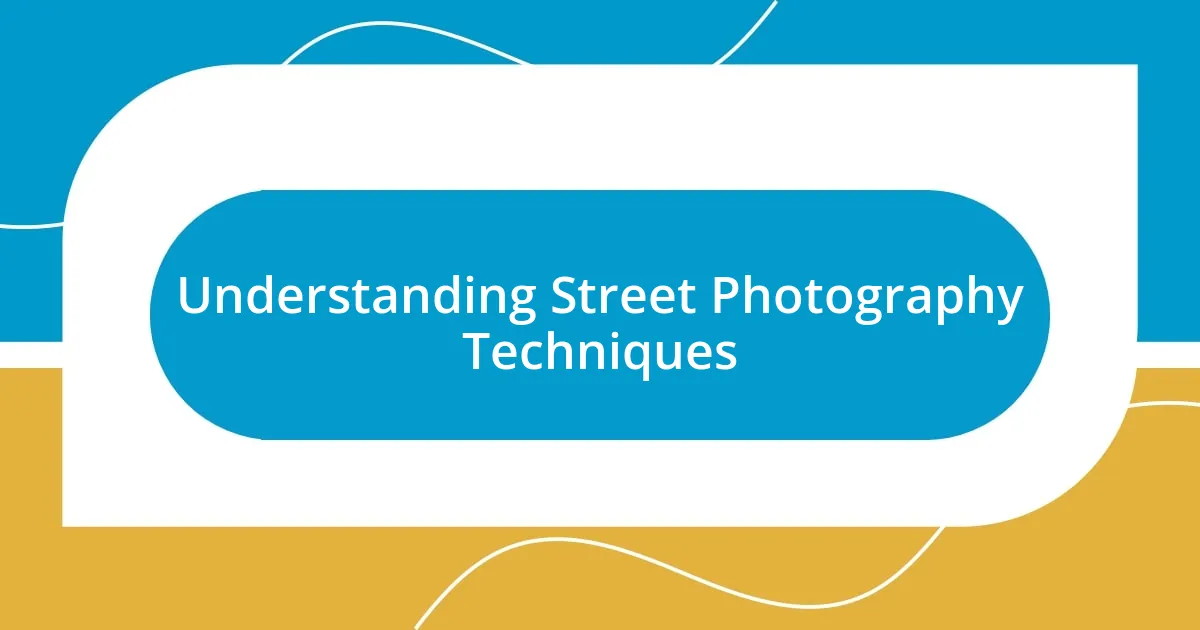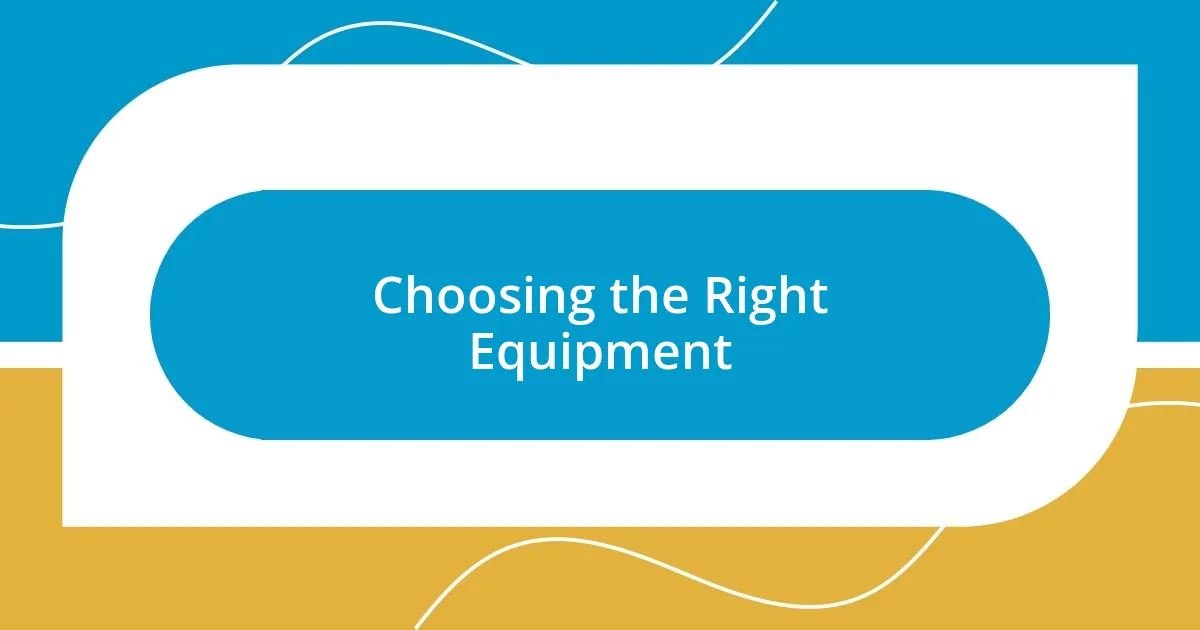Key takeaways:
- Candid shots capture raw emotions and authentic moments that tell compelling stories.
- Engaging with subjects fosters genuine connections, enhancing the emotional depth of photographs.
- Post-processing techniques, like adjusting contrast and cropping, can significantly elevate the storytelling aspect of street photography.
- Being present and observant in everyday life allows photographers to capture meaningful interactions and unique narratives.

Understanding Street Photography Techniques
One technique I often embrace in street photography is the use of candid shots. I remember a day in New York City when I captured a fleeting moment of a street musician lost in his music. The raw emotion on his face was captivating, and it reminded me how powerful unguarded moments can be; they tell more of a story than posed images ever could.
Another approach I find invaluable is mastering composition. I once stood at a busy intersection, waiting for the perfect alignment of pedestrians and surrounding architecture. The thrill of catching that precise moment, where everything harmonizes, fills me with such joy. Isn’t it fascinating how a simple shift in frame can transform a scene from mundane to magical?
Lastly, I can’t stress enough the importance of being present in the moment. Once, while wandering through a local market, I noticed a young girl joyfully interacting with her surroundings. Capturing that genuine playfulness took patience and attentiveness. How often do we allow ourselves to fully soak in our surroundings? I believe that a keen sense of awareness is crucial; it allows us to spot those fleeting scenes that can make street photography so rewarding.

Choosing the Right Equipment
Choosing the right equipment in street photography can feel overwhelming, but I believe in keeping it simple. My go-to gear has been a lightweight mirrorless camera. I remember the first time I switched from a bulky DSLR. I felt liberated! This camera allows me to blend in seamlessly with the crowd, making it easier to capture authentic moments without drawing too much attention to myself.
When selecting your equipment, consider the following:
- Lens choice: A versatile prime lens (like a 35mm) offers sharpness and a natural perspective.
- Camera size and weight: Opt for something portable; it encourages spontaneous shooting.
- Camera settings flexibility: Manual settings give you control in various lighting conditions.
- Durability: Weather-sealing can be a lifesaver if you find inspiration during unexpected rain showers.
Having the right tools can truly enhance your street photography experience, helping you focus more on the moment rather than fiddling with your gear.

Observing Everyday Life Moments
Observing everyday life moments brings an extraordinary layer of authenticity to street photography. I recall a quiet afternoon at a local café, where I noticed an elderly couple sharing a slice of cake. Their laughter and the way they leaned toward each other captured a tender intimacy. It’s these seemingly mundane interactions that, when framed correctly, can evoke powerful emotions. I love how one photograph can speak volumes about love and companionship, don’t you?
Another instance that truly moved me was during a bustling farmers’ market. There was a moment when a child excitedly pointed at colorful flowers while her father crouched down, sharing that joy. I didn’t rush to snap the shot; instead, I held my breath and waited for their expressions to connect. The anticipation heightened the experience for me, showcasing how patience can yield breathtaking results, often capturing the essence of everyday life.
I find that observing these moments isn’t just about having a camera in hand; it’s about being attentive and open to the world around us. One day, while walking through a busy street, I paused to watch a street vendor skillfully preparing food. The steam rising against the backdrop of the city rushed over me, enveloping all my senses. Stepping back and taking in that slice of life made the shots I captured feel infused with life and energy, revealing an ordinary scene transformed into an extraordinary narrative.
| Element | Example |
|---|---|
| Candid Capture | Elderly couple sharing dessert |
| Emotion | Joy and intimacy |
| Patience | Child at the market |
| Heightened Experience | Observing a street vendor |

Engaging with Subjects Effectively
Engaging with subjects effectively is all about fostering genuine connections. I often approach subjects with a smile and a friendly nod, letting my warmth and approachability shine through. There was a time when I saw a street performer passionately playing the guitar in a park. Instead of just snapping a quick photo from a distance, I walked over, complimented his music, and asked if I could capture him in action. That simple interaction led to him striking a playful pose, infusing our exchange with energy that reflected in the shots.
I find that openness creates an atmosphere ripe for authentic expression. Once, while wandering through an art fair, I noticed a woman deeply engaged with a painting. Instead of interrupting her, I took a moment to watch her reactions. When I eventually asked for her permission to photograph her, I felt as though I had captured a beautiful blend of focus and wonder. That image conveyed the love for art she embodied, making it much more than just a portrait—it told a story.
Emotional resonance plays a crucial role in my photography. I remember an afternoon at a local skate park, where the dynamics between skaters were palpable. I hesitated to shoot initially, wanting to grasp the vibe. When I finally started engaging with them, asking about their tricks and whether they’d mind me capturing their moves, it transformed my approach. Their confident expressions, mixed with joy and a bit of mischief, added layers to the photos that I simply wouldn’t have achieved without that connection. Wouldn’t you agree that the best photographs often emerge from shared moments?

Capturing Emotion and Story
When it comes to capturing emotion, I can’t help but reflect on an evening I spent wandering through a lively street festival. I stumbled upon a mother comforting her child who had just fallen. The way she embraced him, whispering sweet reassurances amidst the sounds of laughter and music, pulled at my heartstrings. Isn’t it interesting how a snapshot of vulnerability can resonate? That image became a powerful reminder of our innate desire for connection, transforming a fleeting moment into an everlasting memory.
In my experience, storytelling in street photography often lies in the subtleties. I recall a quiet moment at a bus stop when an elderly man sat beside a young backpacker. They exchanged no words, but their fleeting glances spoke volumes—an entire narrative of generational contrast and shared humanity unfolded before my eyes. I quickly raised my camera, knowing that capturing this silent exchange would evoke introspection in anyone who saw it. Can photographs really bridge the gap between different lives and experiences? I believe they do.

Post-Processing Tips for Street Photos
Post-processing is where I find unique magic in my street photography. One of my go-to tips is to embrace contrast and saturation. I remember editing a moody shot of a rainy street scene where the colors felt washed out. After a quick tweak to boost those hues and deepen the shadows, the image transformed into a captivating composition that really captured the essence of that dreary yet beautiful day. Isn’t it fascinating how a few adjustments can breathe new life into a photograph?
I also find that cropping can significantly enhance the storytelling aspect of my images. There was a time when I captured a bustling market scene that felt too cluttered at first glance. By tightening the crop, I was able to draw focus on a vibrant fruit stall, showcasing the array of colors while minimizing distractions. This simple change not only elevated the photo aesthetically but also honed in on the vibrancy of that moment. Have you ever noticed how sometimes less really is more?
Lastly, I can’t stress enough the power of grain and texture in post-processing. One evening, I shot street performers under dim lights, and the resulting images looked flat and lifeless. By adding a touch of grain, I managed to evoke the gritty atmosphere of the scene, channeling the energy and spontaneity of that vibrant night. This layer of texture can transport viewers right back into the moment, don’t you think? Each of these techniques allows me to reflect my vision and emotions as a photographer, enriching the stories I strive to tell through my lens.














